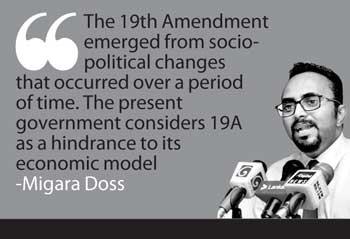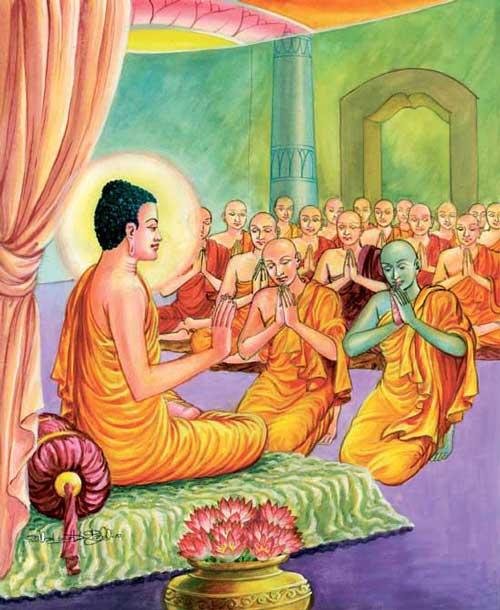08 Feb 2020 - {{hitsCtrl.values.hits}}
When there is direct comprehension of a fact of life, the conscious, subconscious and unconscious minds realise it, leaving no doubts about the truth
The Dhamma is not a doctrine, ideology or philosophy; it is the truth and reality, all mundane efforts by so-called erudite scholars standing on the pratajjana pedestal cannot prove or disprove it
 Lord Buddha told the first sixty Arahants: “Go forth, O Bhikkhus, one in each direction, preach the Dhamma for the good of many, for the welfare and happiness of many, proclaim the holy blameless life for the good of the world.” Later, Emperor Asoka sent emissaries to Sri Lanka, Afghanistan, Syria, Persia, Iran, Egypt, Greece, Italy, Turkey, Cambodia, Burma, Thailand and Vietnam to spread the message of Buddhism.
Lord Buddha told the first sixty Arahants: “Go forth, O Bhikkhus, one in each direction, preach the Dhamma for the good of many, for the welfare and happiness of many, proclaim the holy blameless life for the good of the world.” Later, Emperor Asoka sent emissaries to Sri Lanka, Afghanistan, Syria, Persia, Iran, Egypt, Greece, Italy, Turkey, Cambodia, Burma, Thailand and Vietnam to spread the message of Buddhism.
The first-ever Buddhist council was held on Navam Poya Day. After the passing away of Lord Buddha, senior ArahantVen. Mahakassapa Thera, the former Brahmin, presided over the first Buddhist Sanghayana (council). He became an Arahant after being with the Buddha for only eight days. Sariputta and Moggallana Theras were appointed as the two chief disciples (Aggarasavakas) on Navam Poya Day. Sariputta was “Dharmasenadhipati,” the most prestigious position while Moggallana was “Dharma Purohita.”
Lord Buddha held the first congregation at Veluvanaramaya in Rajagaha on Navam Poya Day. Also on Navam, listening to “Vedana Pariggaha Sutta” expounded by the Buddha to Dighanaka, Sariputta attained Arahantship. It was on Navam Poya Day that the Buddha delivered a sermon on “Ovada Prathimoksha” to chief disciples Sariputta and Moggallana Theras.
There were speculations as to why some of the senior Sangha were overlooked in making these significant appointments. To clear misgivings, the enlightened one related an exciting story woven round Sariputta and Moggallana in a previous birth during the time of Buddha Anomadassi. Sariputta, born during that era, was known as Sarada. He inherited enormous wealth and distributed money among the poor. As the story goes, he gained Atasamapatti – eight attainments through meditation. He had a friend by the name of Siriwaddane. At the end of a sermon preached by Buddha Anomadassi,Siriwaddane was assured that he would become one of the chief disciples of Gautama the Buddha. Siriwaddane too offered alms to Anomadassi Buddha and aspired for the second chief disciple’s post.
The Buddha’s announcement of passing away [Parinibbana] within three months is also another event associated with Navam Full Moon.
In the passage of ‘truth,’ one must appreciate that mere acquisition of knowledge is not enough; realisation by oneself is the key. Acquiring knowledge by listening to others or by reading affects only the surface of consciousness
DR. PEEBLES, ARRIVAL OF COL. HENRY OLCOTT AND PANADURA VAADAYA 
In 1873, there was much derision among Buddhism and Catholicism through various literature written in vernaculars which Christians (Weslyites), who arrived in the island with Dutch invaders, circulated to spread their faith. This was beside the attempts to convert Buddhist children through the school system. Ven. Mohottiwatte Gunananda Thera challenged Christians to defend their faith. Christian clergy accepted this leading to several public debates starting from 1866 and the last (the world famous) at Panadura in August 1873.
A book titled ‘Buddhism and Christianity Face-to-Face’ – containing a comprehensive description of all eight speeches delivered at the debate – was published in 1875 in Americaby Dr. James Peebles. Dr. J.M. Peebles (MA., PhD: 1822-1922) was the President of Psycho-Therapeutic Society of London. The text received wide publicity in America. Colonel Olcott was one American scholar who converted to Buddhism after reading the Dhamma facts expounded by Dr Peebles. Colonel Henry Steele Olcott arrived in Sri Lanka in 1880. He died 113 years ago on February 17, 1907at Adyar in Madras.
“A large audience estimated at five to seven thousand thrilled to the cut and thrust and party of the disputant, and in a period given to developing confrontations between Christianity and resurgent Buddhism, this particular debate excited much interest and produced the greatest impact….on his third visit to island in 1897, he teamed up with Col. Henry Olcott [1880-1906] whom he had known for almost twenty-five years in promoting Buddhist revivalist movement in Ceylon” - Ceylon Observer (1873)

Ven. Migetuwatte Gunananda Thera argued with several scholarly Christian missionary priests, all well-acquainted with Buddhism. They possessed a sound knowledge of Pali language too. The Christian supportive team included Wesleyan priests well-versed in Tripitaka and other chronicles; D.J. Gogerly, another Buddhist scholar; B. Clouch – one of them was the editor of the Sinhala-Pali dictionary; William Harvard, the author of several books in Sinhala; and Spence Hardy, who wrote on Sinhala literature and Buddhism.
The Panadura debate received wide coverage in the press; the Ceylon Times (later Times of Ceylon) and Ceylon Observer sent special correspondents to cover the event, they were asked to observe rules on fair reporting. However, it seems that Observer published biased news favouring the Christian team. In the September 5, 1873 issue of Times, the writer came across a ‘Letter to the Editor’ by Dr. George Eliot, a reader who challenged Observer correspondent for ‘utterly unfounded’ comments referred to as, “…Migetuwatte had to give into his superior in Pali, Fr. David Silva, on three very material points…the priest lingered and still lingers along with his confreres, to attempt to answer…”
Many others including writers believed so, but a broad study of the eight speeches made by the two parties create reservations on who won or who lost. The Dhamma is not a doctrine, ideology or philosophy; it is the truth and reality, all mundane efforts by so-called erudite scholars standing on the pratajjana pedestal cannot prove or disprove it. What is important here is like in cricketing parlance, not ‘who won and who lost’ but to reflect on how the debate was performed; the impact of it and
final outcome.
In the passage of ‘truth,’ one must appreciate that mere acquisition of knowledge is not enough; realisation by oneself is the key. Acquiring knowledge by listening to others or by reading affects only the surface of consciousness. One cannot reach deeper layers of our being merely through acquisition of knowledge.
When there is direct comprehension of a fact of life, the conscious, subconscious and unconscious minds realise it, leaving no doubts about the truth. We realise in our life by direct experience. Touching very hot objects can burn. With very hot objects, there is not even a little doubt about what one must do. In contrast, a child who has merely heard someone say the fire burns or do not touch. That’s mere knowledge but no realisation of the fact; the child may feel curious to touch the object. Layer by layer, you can realise the facts of life. Truth of continuation dawns only when you reach there!
Animals are exactly the same as you and I, and perhaps more ‘advanced’ because they have intuitive and perceptive powers we cannot even dream of. They love, feel, get scared, cry, laugh… and they know when someone is going to kill them, that is for our food. We think we are superior in that; we have mastered the art of killing different varieties of animals adopting different methods and we use those skills all the time. Each one of us has been linked in so many different ways to animals we encounter – including the ones we kill for meat. Animals carry this knowledge, yet they do not hate us; we think we are superior humans; with our utterly selfish attitudes, we have lost all intuitive capacities we originally carried in our genes over the evolutionary process.
May all beings be happy!
25 Oct 2024 1 hours ago
25 Oct 2024 3 hours ago
25 Oct 2024 3 hours ago
25 Oct 2024 3 hours ago
25 Oct 2024 4 hours ago